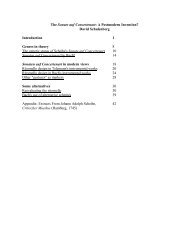SEVEN PAPERS ON EXISTENTIAL ANALYSIS ... - Wagner College
SEVEN PAPERS ON EXISTENTIAL ANALYSIS ... - Wagner College
SEVEN PAPERS ON EXISTENTIAL ANALYSIS ... - Wagner College
Create successful ePaper yourself
Turn your PDF publications into a flip-book with our unique Google optimized e-Paper software.
alone, without objects of which there is consciousness. Second, each kind of object of<br />
consciousness is answered by a different mode of being-consciousness, which is itself a relation<br />
between the someone who is consciousness and an object of a certain kind (percept, memory,<br />
image, fantasy, hallucination, and so on). An account of what happens when there is<br />
consciousness must begin with the objects of consciousness, not with the other pole of the<br />
relation of being-consciousness (the self). A basic characteristic of the objects of consciousness<br />
is their kinetic nature. What at first glance seems to be distinctive only of memories applies<br />
equally to all objects of which I am consciousness. I say of a recollection that "it came to me,"<br />
but in perception, too, as well as in the other modes of being-consciousness, the object of which<br />
I am consciousness comes to me and confronts me, even when this object is an absence, as it is<br />
in the case of existential consciousness.<br />
We term the objects of consciousness things. A thing may be real or imaginary, physical<br />
or linguistic. Thing is the most general term we have for whatever can be an object of beingconsciousness,<br />
which meets the things that come to it. Only what gives itself in confronting me<br />
can be perceived or remembered, imaged or dreamed, willed or validated, as the case may<br />
be. Phenomenological investigations have shown that perceptual consciousness grasps only<br />
one "side" or profile of a thing at a time. An object of being-consciousness is subject to that<br />
perspectival restriction determined by the particular setting, situation, or place when there is<br />
consciousness. The notion of a "side" in phenomenology applies in general to the aspect of any<br />
thing that presents itself to me in any mode of being-consciousness – except existential<br />
consciousness. What I might perceive or otherwise make of what the other is is presented to me<br />
perspectivally, but I am not presented with different sides of existence. Existence does not have<br />
perspectives. When I say I have seen a side of someone that I "know only too well" or "had never<br />
seen before," I am referring to what I take him to be, not to his existence.<br />
Perceptual consciousness has been shown to depend to a marked degree on the status<br />
of one's sensorium, but memory and imagination and the other modes of consciousness are also<br />
affected by one's overall disposition. Existential consciousness, by contrast, is a matter of all or<br />
nothing.<br />
I. Consciousness and Existence<br />
Let us look once again at the structure of being-consciousness in its relation to existence. Beingconsciousness<br />
is the "face" of my existence. It is at the things of which I am consciousness. Beingconsciousness<br />
is my existence at the things that confront me. In different terms, existential<br />
consciousness is at the existence of the other. The characterization of consciousness in "where"<br />
terms may mislead us to incorrectly suppose that consciousness is spatial, like the things in the<br />
natural world that we experience, but only the body of the human being who is consciousness<br />
(both the body he has and the body he is) is spatial. An object of which a human being is<br />
consciousness is one pole of that relation we call being-consciousness, but it is equally true that<br />
the body of the human being who is consciousness of such an object is also a point toward<br />
which the relation is directed. Being-conscious might be represented in this way: ab, where a<br />
is a modality of being consciousness, such as perception, and b is an object of that modality. My<br />
being-consciousness, then, is directed both to me and to the objects that confront me. Empirical<br />
psychologists have mistakenly assumed that consciousness is unidirectional, like an arrow, aimed<br />
by an ego toward an object of interest to it (19).<br />
With respect to the body of an other, when I validate his existence, my beingconsciousness<br />
is at the body of an other (centered in his face, as it has been since infancy) as<br />
much as it is at my own body (though it hard to localize that place in my body). What is meant<br />
by "at" in these formulations? We may think of it as being used in a temporal sense, as in the<br />
sentence "I will meet you at 10 o'clock this evening." To say that the consciousness I am is at its<br />
object means that it confers on the thing my temporality, the time of my existence. Being-















